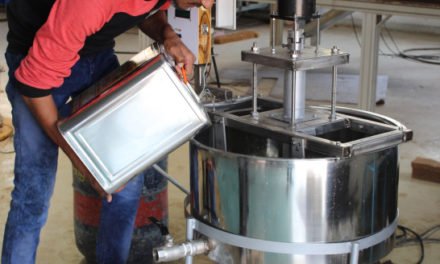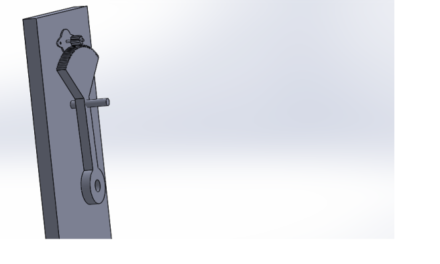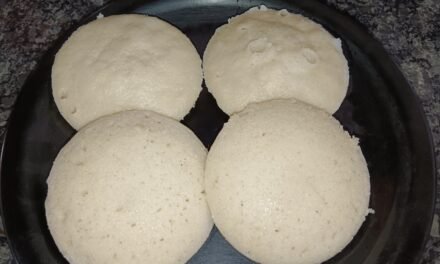Introduction :
Azolla is a water fern that floats on the surface of fresh water ponds, rivers, and flooded fields in the tropics and subtropics of both the New and Old Worlds. Its size is typically 1-2.5 cm in diameter, but some species can achieve the size of 15 cm or more. It belongs to a derived group of ferns Azollaceae and is closely related to several other aquatic taxa such as Salvinia and Marsilea.
Biology of azolla:
- It is one of the few pteridophyte lineages (any of a division (Pteridophyta) of vascular plants (such as a fern) that have roots, stems, and leaves but lack flowers or seeds) that have evolved heterospory (with male and female spores in different sizes), a condition that precedes evolution of the seed.
- Traditionally, seven species are recognized and they are divided into three series, with
- A. filiculoides, A. rubra, A. caroliniana, A. microphylla, and A. mexicana in section Azolla (found in tropical areas of the Americas, New Zealand, and Australia),
- A. pinnata in section Rhizosperma (occurring in Africa, Australia, and Asia),
- And A. nilotica in section Tetrasporocarpia (distributed only in Africa)
- A molecular phylogenetic study has now more or less confirmed this taxonomic scheme with the only change that A. nilotica and A. pinnata form a monophyletic instead of a paraphyletic group as in the morphological cladistic analysis .
- The cyanobacteria are housed in a cavity of dorsal lobe of the leaf.
- All of the strains isolated from these seven Azolla species belong to Anabaena azollae.
Reproduction / Multiplication of azolla:
- Azolla has both sexual and asexual reproduction.
- During sexual reproduction, each (female) megaspore contains a small colony of Anabaena filaments bearing akinetes (spores of the cyanobacterium), and so the bacterium is passed down to the next generation of the water fern.
- Its asexual reproduction is achieved simply by multiplication of fragmented fronds (fern leaves).
- Under ideal growth conditions, the water fern grows and reproduces (asexually) extremely fast, often able to double its weight in 2-5 d.
Azolla (mosquito fern, duckweed fern, fairy moss, water fern) is a genus of seven species of aquatic ferns in the family Salviniaceae. They are extremely reduced in form and specialized. It can fix atomospheric nitrogen, carry out photosynthesis and uptake nutrients from its surrounding environment through its root system. It has wide range of use including fodder for dairy cattle, pigs, chicken, ducks and fish, used as a biofertilizer.
Need of project :
In Vigyan ashram, we are facing problem in multiplication of azolla,this could be due to diferent factors such as temperature and humidity, deficeincy of NPK, deficeincy of micronutrint, pH of water etc. Primary use of azolla rightnow in may 2020, is fish feed for Tilapia.Otherthan this we require azolla as a nitrogen source.
Objectives:
- To study the effect of :
- Temperature
- Humidity
- pH
- Micronutrient
- NPK on azolla growth patteren.
- To boost availability of azolla for composting.
- Use of azolla as a feed for fish and animals.
Trail : 01
Protocol:
- Existing four beds converted into five bed with different chemical composition ( 01/05/20 ).
- Then beds were refilled with water (700 L/bed ) and treated with 5 gm bleaching powder. ( 02/05/20).
- Equidistant foggers were fixed and labelled beds ( 03/05/20 )
- Composition of each bed is as follows:
| Azolla Bed No | Chemical | Full form | Concentration |
| Bed No :1 | 0:52:34 | Potassium phosphate | 100 gm |
| Bed No :2 | MgSO4 | Magnesium sulphate | 50 gm |
| Bed No :3 | SSP | Single super phosphate | 100 gm |
| Bed No :4 | 0:52:34 + MgSO4 | Potassium phosphate + magnesium sulphate | 100 gm + 50 gm |
| Bed No :5 | Soil + Slurry + 0:52:34 + SSP + MgSO4 + Mineral Mixture | Potassium phosphate + magnesium sulphate + Single super phosphate | 5 kg + 3 L+ 100 gm +100 gm+50 gm +20 gm |
- Addion of azolla i.e. 1.8 kg into each bed.
Now, The structural details of these azolla beds are as follows:
- Dome is called as azolla dome. This dome is divided into five equal parts.
- Depth = 0.6 ft, Length = 8 ft, Breadth = 5 ft
- Total amount of water required foe each bed = 700 L.
- Foggers are fixed to maintain humidity.
- Total no of foggers : 14
Roll of chemicals is as follows :
- 0:52:34 : Formulated using Phosphorous 52% and Potassium 34%, Special NPK (00-52-34) is a 100% water soluble fertilizer which promotes the soil fertility. It is a great source of P & K soil nutrients for plants, specially useful during early and end stages of crop growth.
- MgSO4 : Mg involved in photosynthesis and sulfur activate plant enzyme system. Deficiency of mg affect plant colour. In short Mg required for plant to give green colour.
- SSP : Ensures a large number of nodules on the roots, which fix atmospheric Nitrogen directly into the soil and also increase Nitrogen uptake.
- Mineral mixture :
- Bleaching powder : To resist/avoid the growth of algae. Beacause algae has symbiotic relationship with azolla.
- Soil : To provide microbes and micronutrients.
Parameters considered during Azolla reading are categorized into 3 main parts:
- Water Testing :
- Includes pH, EC, TDS, Hardness, Potassium (K), water temperature.Water temperature, pH, EC and TDS has been taken at 4:00 pm daily. And hardness and potassium content calculated after 2 days.
- Climatic conditions :
- Includes Temperature and Humidity. Temperature and humidity readings has been taken four times i.e. 8:00 am, 12:00 pm, 3:00 pm and 6:00 pm daily. Both inner and outer temperature and humidity reading has been taken.
- Azolla Harvesting :
- Includes Date, weight and use of harvested azolla.
Air flow within dome:
Hot air will rise up to the top of the dome. A very simple solution to implement a ventilation system will be to install vents on the top of the dome, e.g., a window. The hot air will be able to escape on the top. Thereby, the air pressure inside the dome will be lower than outside. If we want to let the cold air go inside of the dome, it should also contain vents on the bottom of the structure.If this solution is implemented in the dome, there should also be a (automatic) system which can open and close the vents when it is needed. This system has a low energy consumption if we compare it with other possible ventilation systems.
Another solution to ventilate a dome is to use cooling fans. The problem with this solution is that you need a lot of energy in order to power the cooling fans. It is possible to power the cooling fans with solar panels. Since this dome will only use a 12 V battery, it’s almost impossible to use it in this case.
Readings of azolla beds (05/05/20 – 23/5/20)
- Water Testing : https://docs.google.com/spreadsheets/d/1bKUKhH1xpqBjJsAmc_433kefZC10CjeF9-hRCCSh24U/edit?ts=5eafc1e1#gid=0
- Climatic conditions : https://docs.google.com/spreadsheets/d/1bKUKhH1xpqBjJsAmc_433kefZC10CjeF9-hRCCSh24U/edit?ts=5eafc1e1#gid=583583872
Observation :
- Growth of azolla after 6 days:
According to the observation and study, in first 6 days azolla seems green in first bed ( potassium phosphate) , second (magnesium sulphate) and third ( single super phosphate) bed. And it becomes yellow in fourth ( Potassium phosphate + magnesium sulphate ) and fifth bed ( Potassium phosphate + magnesium sulphate + Single super phosphate ).
| Azolla bed No | Causes |
| Bed No : 1 | Observe green due to presence of phosphate. |
| Bed No : 2 | Observe green due to presence of magnesium. |
| Bed No : 3 | Observe green due to presence of phosphate. |
| Bed No : 4 | Observe yellow |
| Bed No : 5 | Observe yellow |
Azolla weight is calculated after 6 days to observe growth changes, which is as follows :
| Azolla Bed No | Weight in gm (after 6 days) | weight in gm (after 6 days) | Weight increased by percent/day |
| Bed No: 01 | potassium Phosphate | 425 | 4.1 |
| Bed No: 02 | Magnesium sulphate | 568 | 5.2 |
| Bed No: 03 | Calcium dihydrogen phosphate | 165 | 1.5 |
| Bed No: 04 | potassium Phosphate + Magnesium sulfate | 105 | 0.94 |
| Bed No: 05 | Soil Slurry + all 3+ mineral mixture | 402 | 3.7 |
- Growth of azolla after 12 days :
Azolla in Bed No. 4 , has lowest weight gain, this is due to precipitation of magnesium phosphate. So non availability of phospharus as well magnesium. Bed No. 2 has highest weight gain may be due to availability of magnesium. Bed No.1 is runner up in the competition where the availability of phosphorus is key factor. If we compare bed 1 with bed 4 potassium availability is same but deficiency is phosphorus.
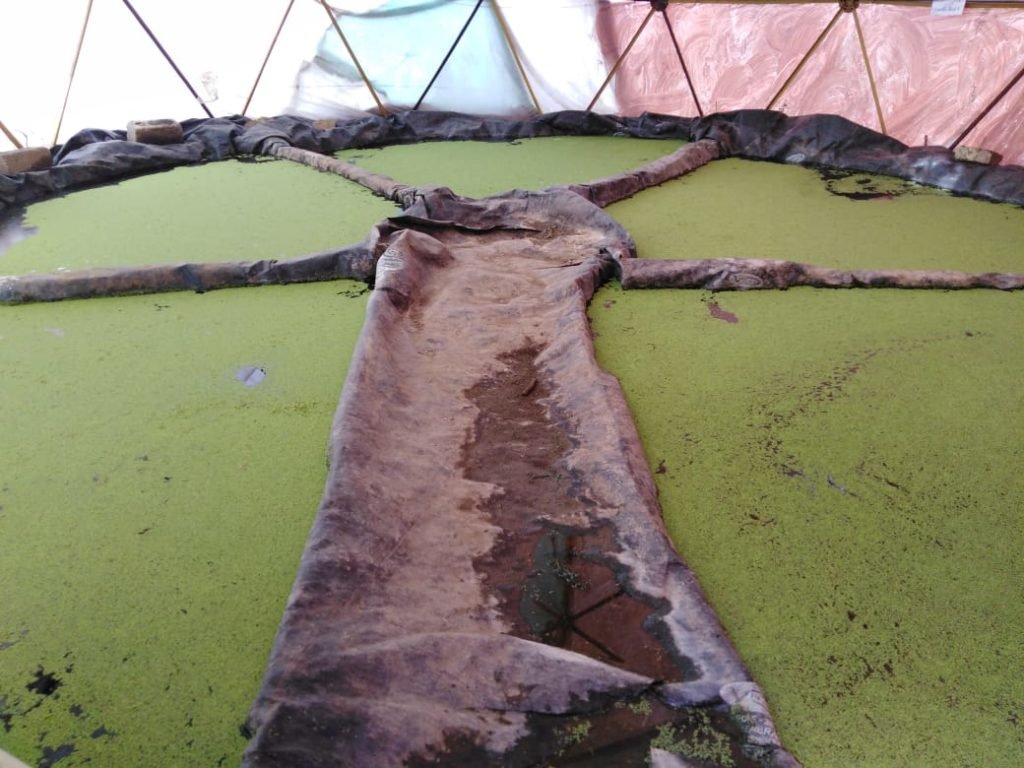
There is no significant change in colour of azolla as compared to first six days, but size of azolla become small. And weight also decreased in first,second and fifth bed. But weight is increased in third and fouth bed which were lowest wt. gain in first six days. This is may be because of precipitation of magnesium phosphate, potassium sulphate is solubalize in water and that potassium sulfate used by azolla for growth.
Azolla weight is calculated after 12days to observe growth changes, which is as follows :
| Azolla Bed No | Intial weight of Azolla | weight after 12 days ) | Wt. loss/gain in gm | wt. loss (%) | wt. increased or decreased per day (%) |
| Bed No: 01 | 425 | 277 | – 148 | 34 (loss) | 2.8 (loss) |
| Bed No: 02 | 568 | 68 | -500 | 88 (loss) | 7.3 (loss) |
| Bed No: 03 | 165 | 354 | 189 | 114 (Gain) | 9.5 (gain) |
| Bed No: 04 | 105 | 512 | 407 | 387 (Gain) | 32.2 (gain) |
| Bed No: 05 | 402 | 446 | -44 | 10.9 (loss) | 0.9 (loss) |
3. Growth of azolla after 19 days :
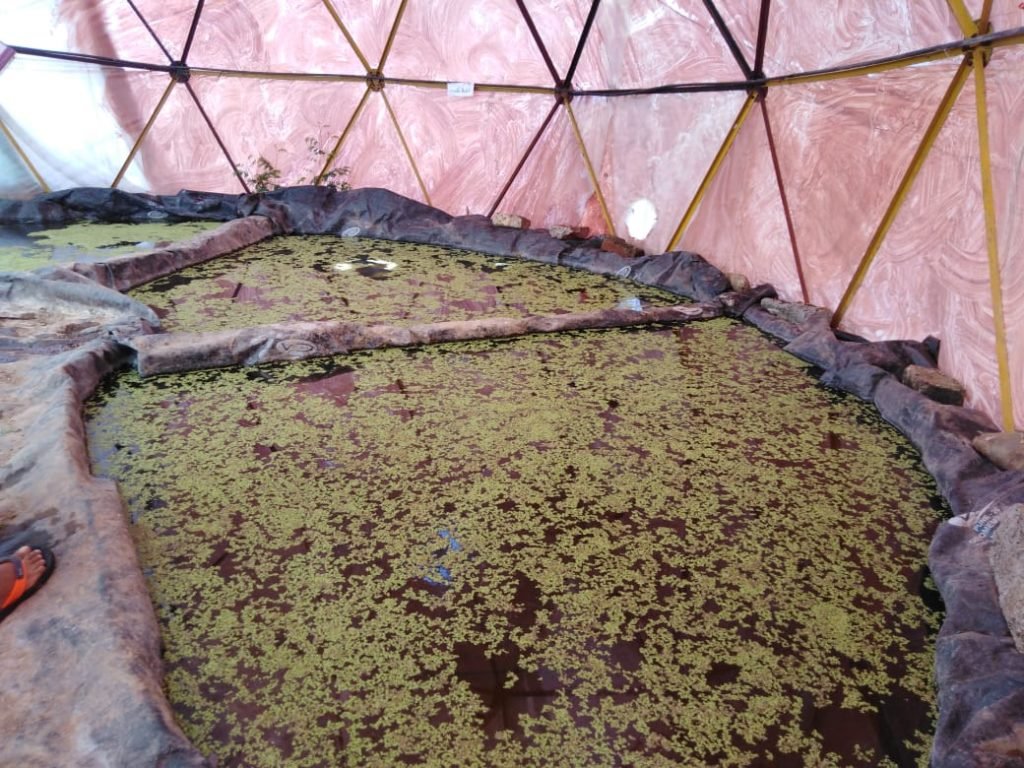
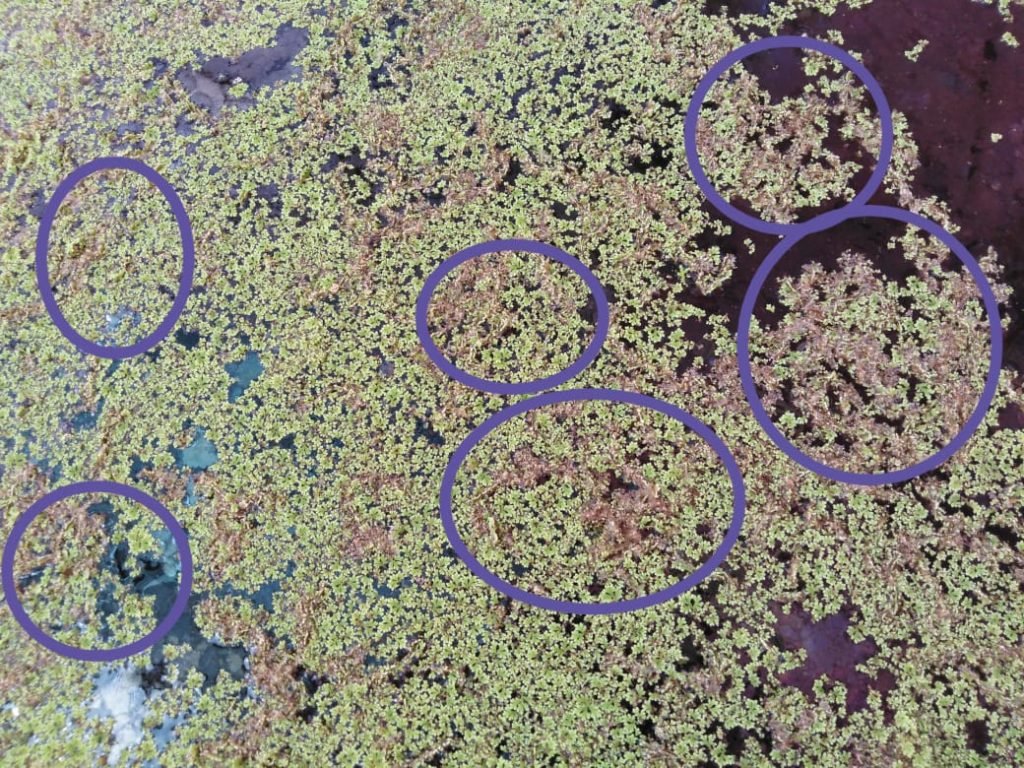
Azolla weight is calculated after 19 days to observe growth changes, which is as follows :
| Azolla Bed No | Initial wt.(wt after 12 days) | Increased / decreased weightof azolla after19 days.(gm) | Wt. loss/gain in gm | Wt. loss/gain in % | Wt. loss/gain per day (after 19 days.) |
| Bed No: 01 | 277 | 155 | -122 | 55.9 (loss) | 2.94 (loss) |
| Bed No: 02 | 68 | 91 | 23 | 133.8 (gain) | 7.04 (gain) |
| Bed No: 03 | 354 | 277 | -77 | 78.24 (loss) | 4.11 (loss) |
| Bed No: 04 | 512 | 272 | -240 | 53.12 (loss) | 2.79 (loss) |
| Bed No: 05 | 446 | 210 | -236 | 47.08 (loss) | 2.47 (loss) |
Weight and size of azolla decreases day by day. And colour also changes from green to red and then brown . Its due to degradation of chlorophyll. In a way this reduce photosynthetic activity means reduce growth .
Trial : 01 (In tray)
- Five trays with dimensions 41 cm length, 30 cm breadth and 7 cm height used to conduct experiment.
- Trays were filled with 4.5 L water each (4/06/20) .
- Trays with chemical composition is as follows:
| Tray No | Chemical composition | Treatment | Initial wt. of azolla. (gm) |
| Tray No 1 | 0:52:34 | 0.55 gm | 20 |
| Tray No 2 | MgSO4 | 0.29 gm | 20 |
| Tray No 3 | SSP | 0.55 gm | 20 |
| Tray No 4 | 0:52:34 + MgSO4 | 0.55 gm + 0.29 gm | 20 |
| Tray No 5 | Soil + Slurry | 0.28 gm + 170 ml | 20 |
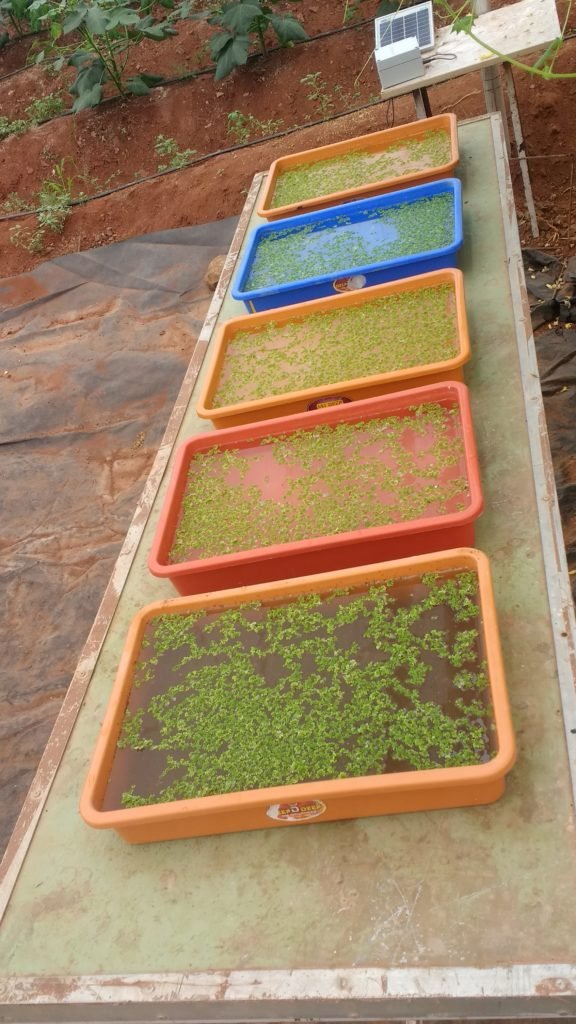
Observation after 6 days (10/06/20) :
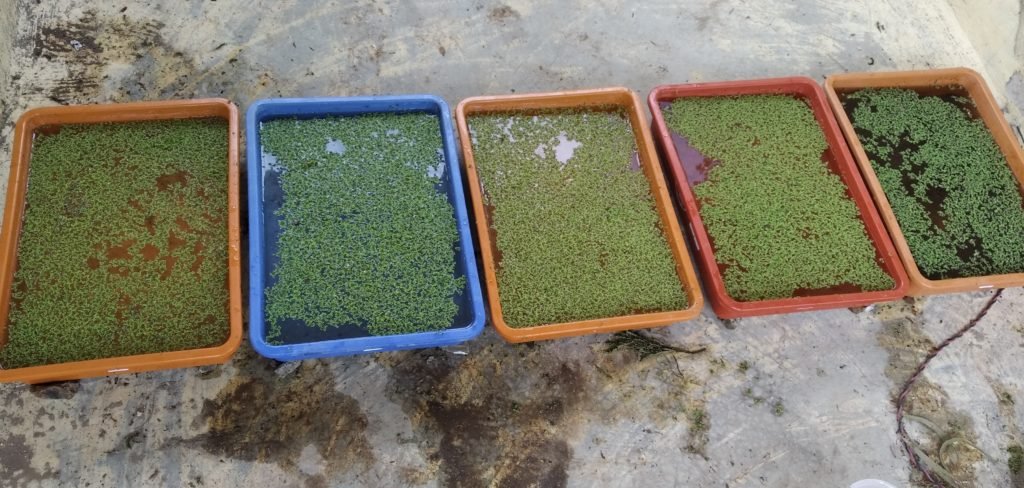
| Tray No | Chemical composition | Initial wt. of azolla | Wt. of sample after 6 days. (gm) | Increase % wt. after 6 days. | Increase % wt. Per day |
| Tray No 1 | 0:52:34 | 20 gm | 50 | 250 | 41.6 |
| Tray No 2 | MgSO4 | 20 gm | 39 | 195 | 32.5 |
| Tray No 3 | SSP | 20 gm | 55 | 275 | 45.8 |
| Tray No 4 | 0:52:34 + MgSO4 | 20 gm | 65 | 325 | 54.1 |
| Tray No 5 | Soil + Slurry | 20 gm | 23 | 115 | 19.1 |
Observations after 12 days : (16/06/20)
| Tray No | Chemical composition | Initial wt. of azolla (after 6 days) | Wt. of sample after 12 days. (gm) | Increase % wt. after 12 days. | Increase % wt. Per day |
| Tray No 1 | 0:52:34 | 50 | 28 | 56 | 4.6 |
| Tray No 2 | MgSO4 | 39 | 46 | 117.9 | 9.8 |
| Tray No 3 | SSP | 55 | 57 | 103.63 | 8.6 |
| Tray No 4 | 0:52:34 + MgSO4 | 65 | 54 | 83.07 | 6.9 |
| Tray No 5 | Soil + Slurry | 23 | 18 | 78.26 | 6.5 |
Trial : 02
Protocol :
- Existing azolla was harvested and beds were refilled with water 700 lit/bed.
- Bubblers were fixed in each bed .
- To study the effect of bubblers on azolla growth, bubblers were fixed in each bed.
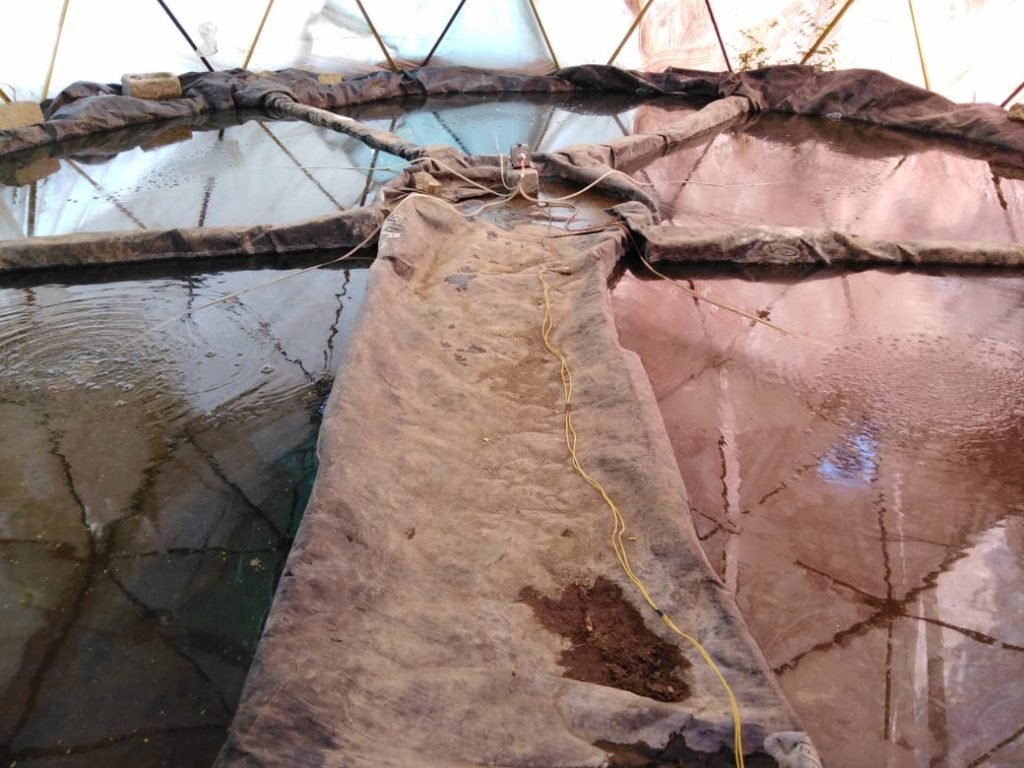
- 2 kg azolla was added in each bed.
- Timer is installed for automization of foggers.
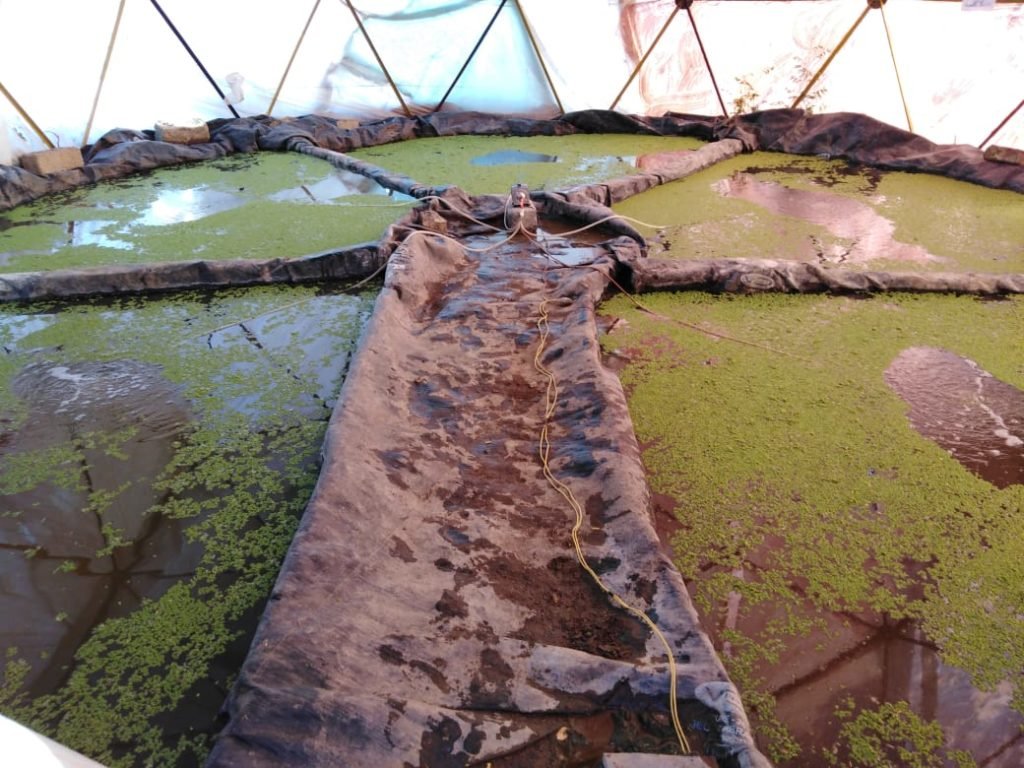
- Chemical composition of Azolla beds is as follows:
| Azolla Bed No | Composition | Treatment |
| Bed No : 1 | Jeevamrut | 9 L |
| Bed No : 2 | Nitrate Culture | 6 L |
| Bed No : 3 | Vermiwash | 25 L |
| Bed No : 4 | Fertilizers (Ca(NO3)2, 13:0:45, Iron, zinc, copper, molybdenum, 0:52:34, 0:0:50, KNO3, MgSO4 ) | 400 gm, 50 gm, 1 gm, 1 gm, 1 gm, 1 gm, 1 gm, 50 gm, 50 gm, 50 gm, 100 g . |
| Bed No : 5 | Slurry | 10 L |
Formulas :
- % wt. gain = wt. gain / initial wt. * 100
- % wt.gain per day = % wt. gain / 6
Observations after 6 days :
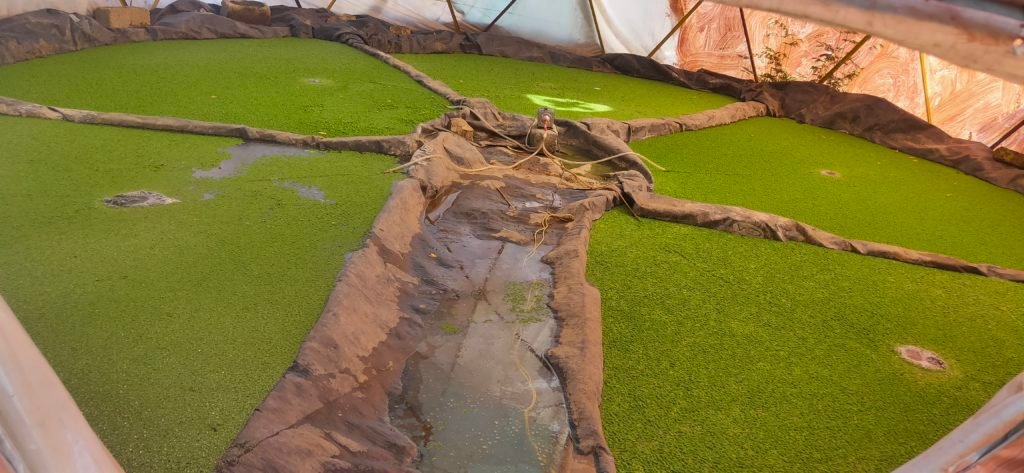
| Azolla Bed No | Composition | Initial wt. per bed (kg) | Increase weight after 6 days (kg) | % wt. Gain | % wt. gain per day |
| Bed No : 1 | Jeevamrut | 2 | 0.059 | 2.95 | 0.491 |
| Bed No : 2 | Nirtrate culture | 2 | 2.55 | 127.5 | 21.25 |
| Bed No : 3 | Vermiwash | 2 | 1.126 | 56.3 | 9.38 |
| Bed No : 4 | Fertilizers | 2 | 1.526 | 76.3 | 12.71 |
| Bed No : 5 | slurry | 2 | 1.572 | 78.6 | 13.1 |
Azolla harvesting details:
| Date | Time | Weight (kg) | Total azolla (kg) |
| 01/06/20 | 6:00 PM | 1kg/bed | 5 kg |
| 03/06/20 | 10:00 AM | 1kg/bed(except bed 1) | 4 kg |
| 04/06/20 | 10:00 AM | 1kg/bed(except bed 1) | 4 kg |
Observations after 12 days:
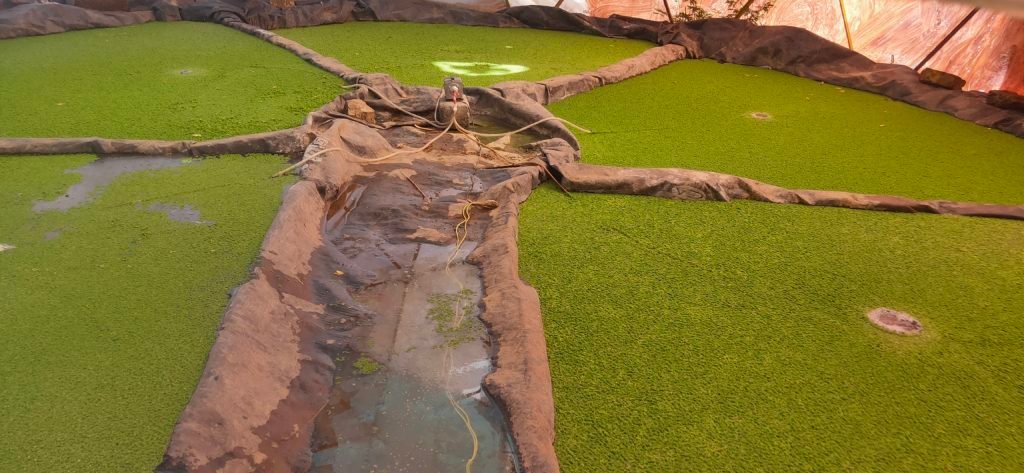
| Azolla Bed No | Composition | Initial wt. of azolla (kg) | Wt. after 12 days | % wt. gain | % wt. gain per day. |
| Bed No : 1 | Jivammrut | 2 | 2.423 | 41.06 | 6.84 |
| Bed No : 2 | Nitrate Culture | 2 | 4.677 | 233.6 | 0.305 |
| Bed No : 3 | Vermiwash | 2 | 3.903 | 195 | 0.57 |
| Bed No : 4 | Fertilizers (Ca(NO3)2, 13:0:45, Iron, zinc, copper, bronze, molybdenum, 0:52:34, 0:0:50, KNO3, MgSO4 ) | 2 | 3.598 | 179.9 | 0.39 |
| Bed No : 5 | Slurry | 2 | 3.000 | 150 | 0.31 |
Observation after 18 days: (12/06/20)
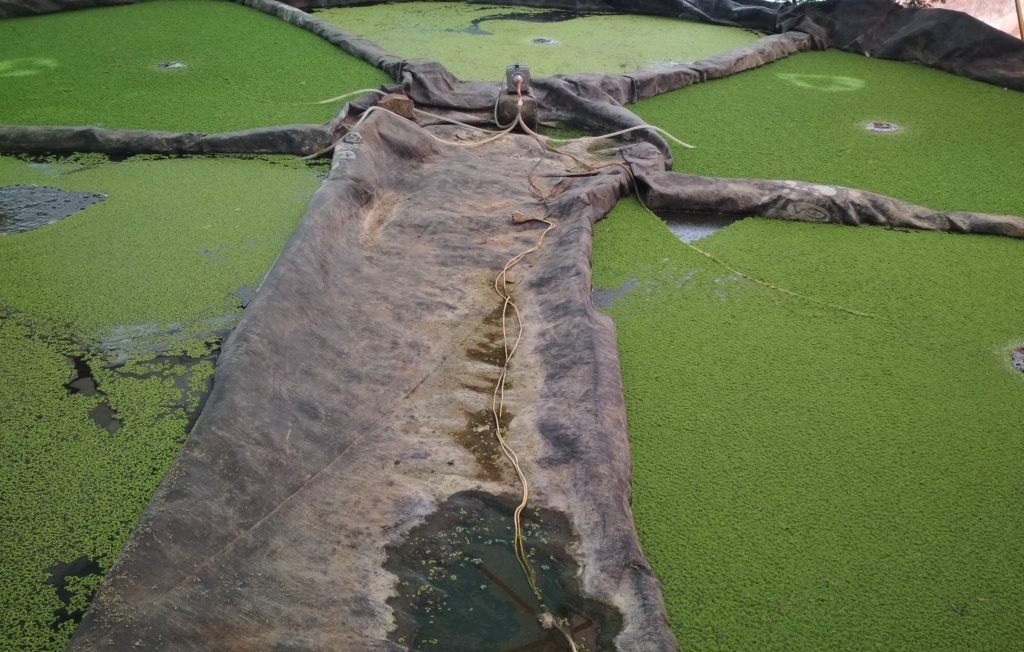
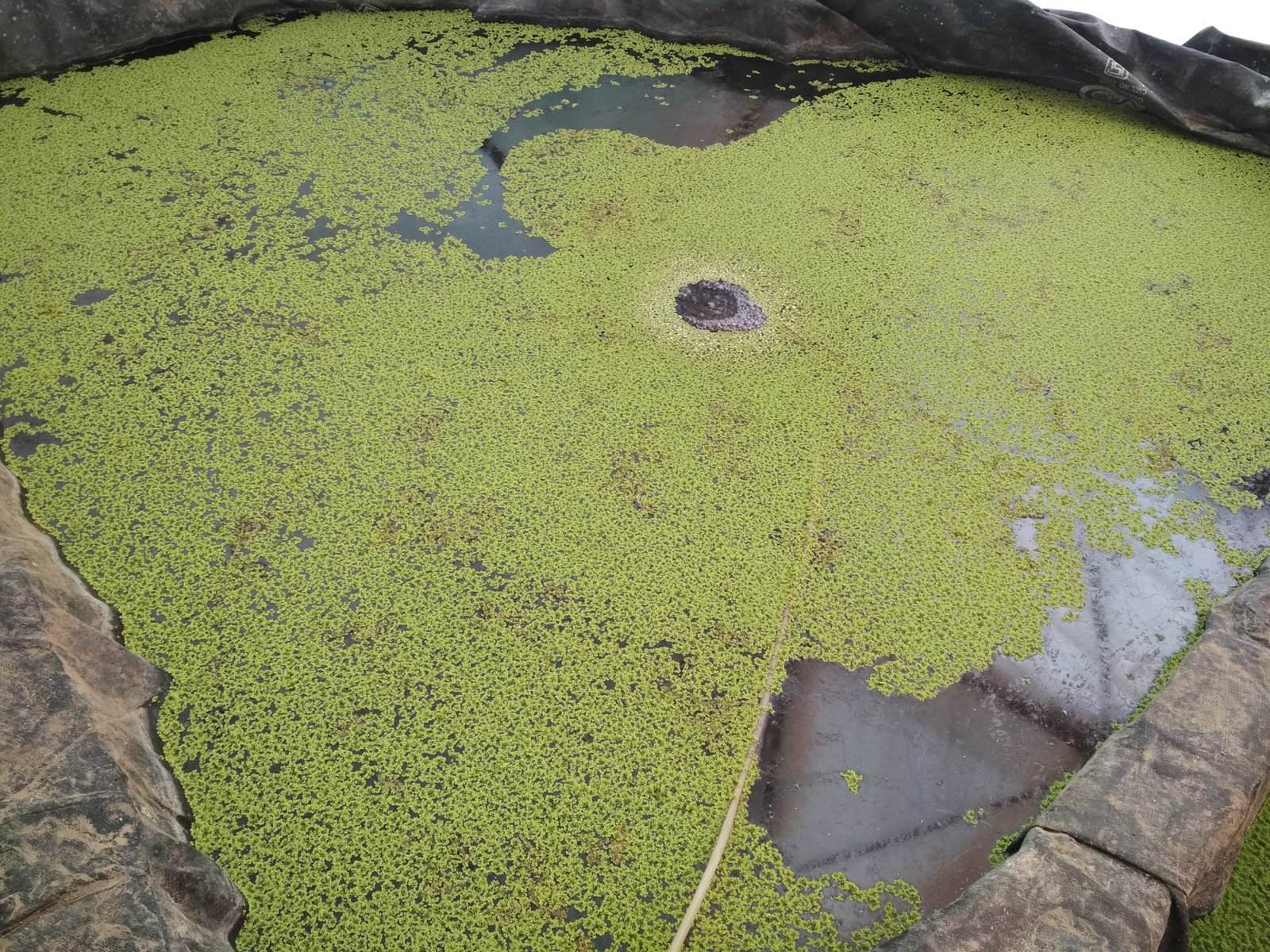
| Azolla Bed No | Composition | Wt. Of azolla after 12 days (kg) | Wt. after 18 days (kg) | % wt. gain/loss | % wt. gain per day. |
| Bed No : 1 | Jivammrut | 2.423 | 2.663 | 1.09 ( gain) | 0.18 |
| Bed No : 2 | Nitrate Culture | 4.677 | 6.53 | 1.39 (gain) | 0.23 |
| Bed No : 3 | Vermiwash | 3.903 | 2.83 | 0.72 (loss) | 0.12 |
| Bed No : 4 | Fertilizers (Ca(NO3)2, 13:0:45, Iron, zinc, copper, bronze, molybdenum, 0:52:34, 0:0:50, KNO3, MgSO4 ) | 3.598 | 5.977 | 1.66 (gain) | 0.27 |
| Bed No : 5 | Slurry | 3.000 | 3.996 | 1.33 (gain) | 0.22 |
Trial : 02 (first repetition)
Protocol :
- Existing azolla was harvested and beds were refilled with water 700 lit/bed for repetation of second trial to determine effect of compositions mention above.
- Treatment of bleaching powder given 2 days before addition of azolla.
Observation after 6 days : (28/06/20)
| Azolla Bed No | Composition | Initial wt. of azolla (kg) | Weight after 6 days (kg) | % wt.Gain | % wt.gain per day |
| Bed No: 1 | Jeevamrut | 2 | 1.190 | 59.5 | 9.91 |
| Bed No: 2 | Nirtrate culture | 2 | 2.75 | 137.5 | 22.91 |
| Bed No: 3 | Vermiwash | 2 | 1.625 | 81.25 | 13.54 |
| Bed No: 4 | Fertilizers | 2 | 2.485 | 124.25 | 20.7 |
| Bed No: 5 | slurry | 2 | 1.960 | 98 | 16.33 |
Observations after 12 days : (3/07/20)
| Azolla Bed No | Composition | Initial wt. of azolla (kg) | weight after 12 days (kg) | % wt.Gain | % wt.gain per day |
| Bed No : 1 | Jeevamrut | 2 | 5.531 | 276.55 | 46.09 |
| Bed No : 2 | Nirtrate culture | 2 | 7.182 | 359.1 | 59.85 |
| Bed No : 3 | Vermiwash | 2 | 5.017 | 250.85 | 41.80 |
| Bed No : 4 | Fertilizers | 2 | 6.101 | 305.05 | 50.84 |
| Bed No : 5 | slurry | 2 | 5.187 | 259.35 | 43.225 |
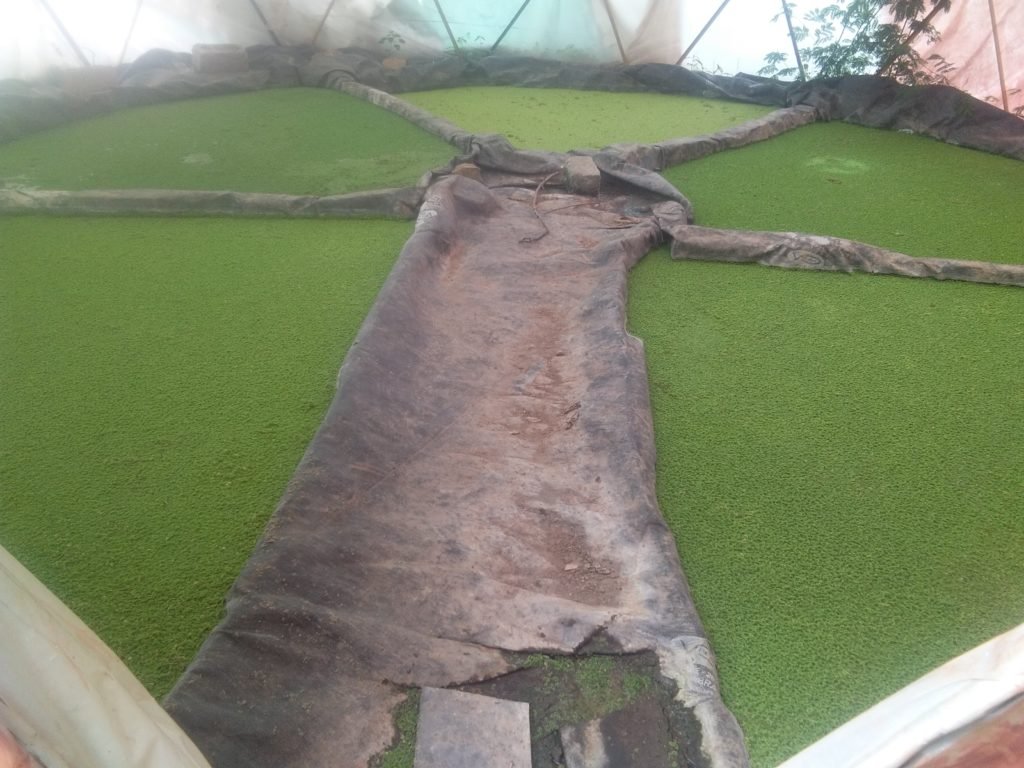
Observations after 18 days : (9/07/20)
| Azolla Bed No | Composition | Initial wt. og azolla (kg) | weight after 18 days (kg) | % wt. Gain | % wt.gain per day |
| Bed No :1 | Jeevamrut | 2 | 2.497 | 124.85 | 20.8 |
| Bed No : 2 | Nirtrate culture | 2 | 2.17 | 108.5 | 18.08 |
| Bed No : 3 | Vermiwash | 2 | 0.984 | 49.2 | 8.2 |
| Bed No : 4 | Fertilizers | 2 | 2.887 | 144.35 | 24.05 |
| Bed No : 5 | slurry | 2 | 3.298 | 164.9 | 27.48 |
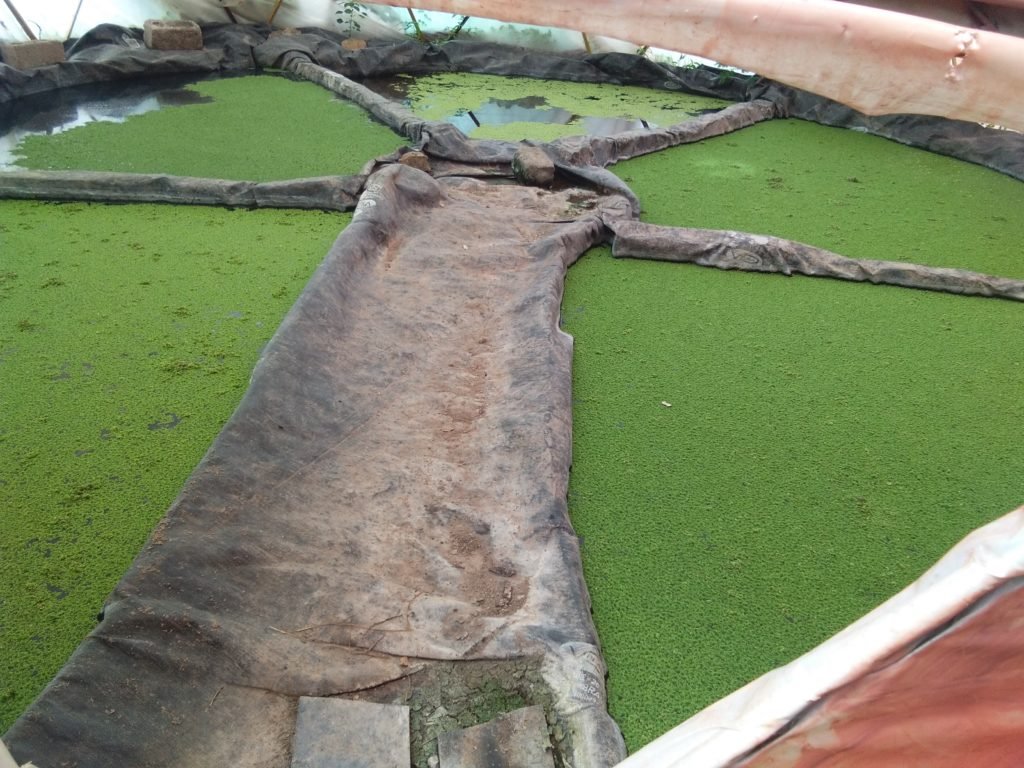
Trial : 02 (second repetition)
- Existing azolla was harvested and beds were refilled with water 700 lit/bed for repetation of second trial to determine effect of compositions mention above.
- Treatment of bleaching powder given 2 days before addition of azolla.
Observations after 06 days:
| Bed No | Composition | Initial wt. Of azolla | Weight after 6 days | % wt.Gain | % wt.gain per day |
| B1 | Jeevamrut | 1 kg | 0.685 | 68.5 | 11.41 |
| B2 | Nirtrate culture | 1 kg | 1.211 | 121.1 | 20.1 |
| B3 | Vermiwash | 1 kg | 0.900 | 90 | 15 |
| B4 | Fertilizers | 1 kg | 1.200 | 120 | 20.18 |
| B5 | slurry | 1 kg | 0.894 | 89.4 | 14.9 |
Observations after 12 days:
| Bed No | Composition | Initial wt. Of azolla | weight after 12 days (kg) | % wt.Gain | % wt.gain per day |
| B1 | Jeevamrut | 1 kg | 2.65 | 265 | 44.16 |
| B2 | Nirtrate culture | 1 kg | 3.452 | 345.2 | 57.5 |
| B3 | Vermiwash | 1 kg | 2.391 | 239.1 | 39.85 |
| B4 | Fertilizers | 1 kg | 2.980 | 298 | 49.66 |
| B5 | slurry | 1 kg | 2.563 | 256.3 | 42.7 |
Comparison :
| Wt. gain after 6 days | Wt. gain after 6 days | % Wt. gain after 6 days | % Wt. gain after 6 days | % wt.gain per day | % wt.gain per day | ||
| Bed No | Composition | First repetition | Second repetition | First repetition | Second repetition | First repetition | Second repetition |
| B1 | Jeevamrut | 59.5 | 68.5 | 59.5 | 68.5 | 9.91 | 11.41 |
| B2 | Nitrate culture | 137.5 | 121.1 | 137.5 | 121.1 | 22.91 | 20.1 |
| B3 | Vermiwash | 81.25 | 90 | 81.25 | 90 | 13.54 | 15 |
| B4 | Fertilizers | 124.25 | 120 | 124.25 | 120 | 20.7 | 20.18 |
| B5 | slurry | 98 | 89.4 | 89.4 | 16.33 | 14.9 |
Comparison :
| Wt. gain after 12 days | Wt. gain after 12 days | % Wt. gain after 12 days | % Wt. gain after 12 days | % wt.gain per day | % wt.gain per day | ||
| Bed No | Composition | First repetition | Second repetition | First repetition | Second repetition | First repetition | Second repetition |
| B1 | Jeevamrut | 5.53 | 2.65 | 276.5 | 265 | 46 | 44.16 |
| B2 | Nitrate culture | 7.18 | 3.452 | 359 | 345.2 | 59.8 | 57.5 |
| B3 | Vermiwash | 5.0 | 2.391 | 250 | 239.1 | 41.8 | 39.85 |
| B4 | Fertilizers | 6.1 | 2.980 | 305 | 298 | 50.8 | 49.66 |
Comparision between three repetition :


Conclusion :
From above data and graphs we can say that azolla growth best in B1 (Nitrate culture) and B4 (Fertilizer), good in B5 (Biogas slurry) and B1 (Jeevmrut). But discussion with J.B.Joshi sir and Dixit sir we come to know that beds were in circular dome so didn’t exactly know what is affecting the growth of azolla. So we had decided that we were going with single composition in all beds to know what affects growth of azolla either composition or temp and humidity.
According to above discussion we set new experiment which is as follows :
| Azolla Bed No | Composition | Amount of composition | Initial wt. of azolla (kg) |
| 1 | Biogas Slurry | 6 L | 1 |
| 2 | Biogas Slurry | 6 L | 1 |
| 3 | Biogas Slurry | 6 L | 1 |
| 4 | Biogas Slurry | 6 L | 1 |
| 5 | Biogas Slurry | 6 L | 1 |
Wt. of azolla after 6 days :
| Azolla Bed No | Composition | Amount of composition | Initial wt. of azolla (kg) | Wt. of azolla after 6 days (gm) | % wt. gain per day |
| 1 | Biogas Slurry | 6 L | 1 | 65 | 10.8 |
| 2 | Biogas Slurry | 6 L | 1 | 293 | 48.8 |
| 3 | Biogas Slurry | 6 L | 1 | 130 | 21.6 |
| 4 | Biogas Slurry | 6 L | 1 | 698 | 116.33 |
| 5 | Biogas Slurry | 6 L | 1 | 353 | 58.83 |
NOTE :
To achieve objectives of these project various trials has been given. But there is a need to work on temperature, Humidity, and light intensity.


